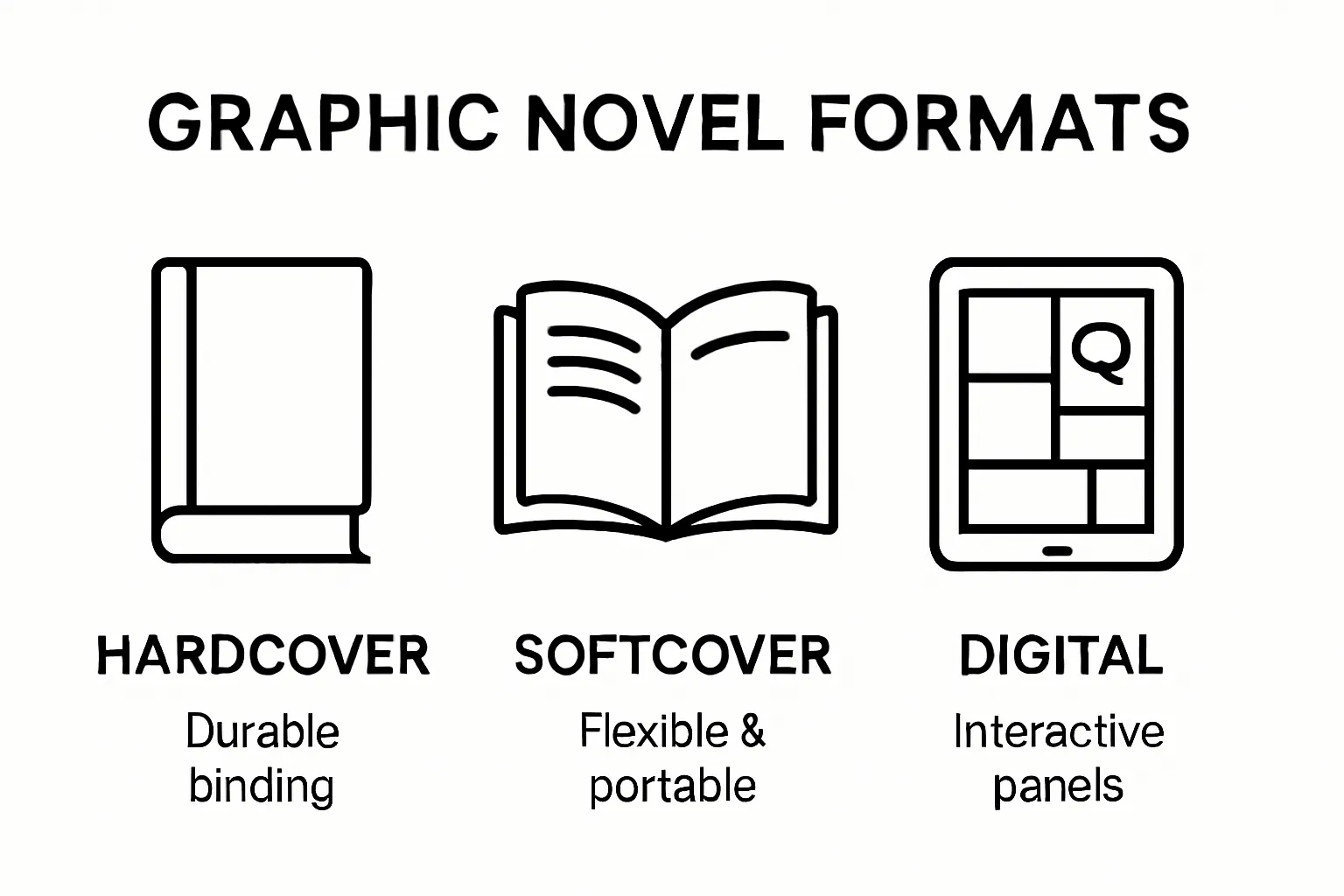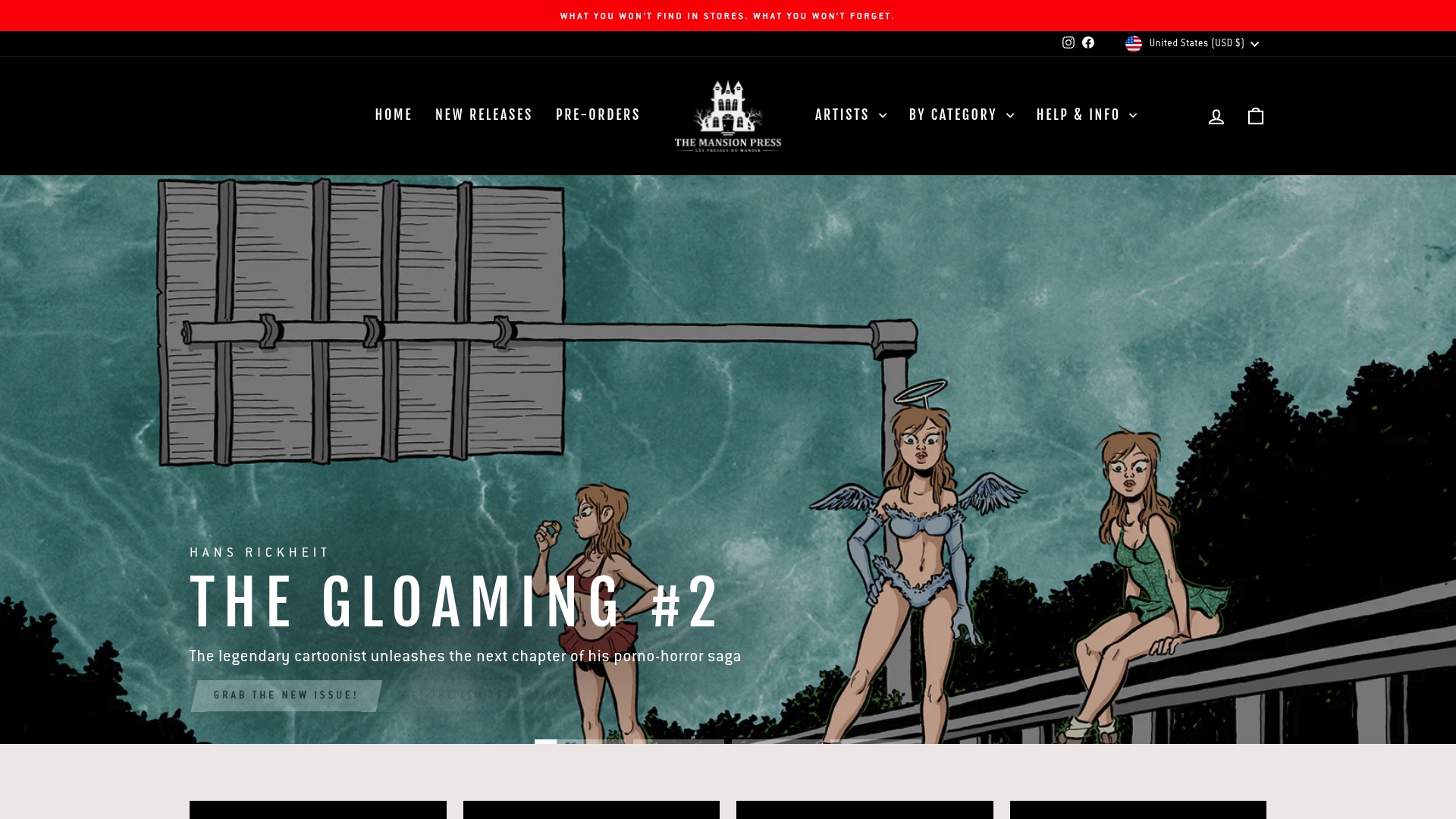Understanding Graphic Novel Formats: A Comprehensive Guide
Graphic novels have changed the way stories are told, mixing art and writing in ways most books never do. Think it is all simple comics for kids? Not even close. Some graphic novels use panel layouts to direct your emotions and thoughts at every turn, making you part of the story in a way plain text cannot touch.
Table of Contents
- What Are Graphic Novels? Exploring The Basics
- The Importance Of Graphic Novel Formats In Storytelling
- Key Characteristics Of Different Graphic Novel Formats
- How Graphic Novel Formats Influence Reader Experience
- Real-World Examples Of Diverse Graphic Novel Formats
Quick Summary
| Takeaway | Explanation |
|---|---|
| Graphic novels combine visual and narrative complexity. | They integrate artwork with thorough storytelling, offering deep character exploration and thematic development. |
| Formats affect storytelling experiences significantly. | Different graphic novel formats like print and digital shape how narratives are presented and perceived by readers. |
| Artistic innovation defines experimental graphic novels. | These formats challenge traditional storytelling through unique visual strategies and structures, pushing creative boundaries. |
| Sequential art conveys rich emotional depth. | The combination of text and imagery allows creators to express complex emotions and themes effectively. |
| Graphic novels provide a platform for marginalized voices. | They enable diverse cultural narratives to be shared, contributing to social commentary and artistic expression. |
What Are Graphic Novels? Exploring the Basics
Graphic novels represent a sophisticated storytelling medium that blends visual artistry with narrative complexity. Unlike traditional comic books, these longer format publications offer comprehensive storytelling experiences that dive deep into character development, thematic exploration, and immersive world building.
Definition and Core Characteristics
A graphic novel is a book length work of sequential art that tells a complete narrative arc. According to the Comic Book Legal Defense Fund, graphic novels distinguish themselves through several key attributes:
- Complete, self-contained storylines
- More substantial page count compared to standard comic issues
- Complex narrative structures
- Advanced artistic and literary techniques
These publications range from fictional stories to non fiction accounts, biographical narratives, and even academic explorations. They utilize sequential art panels to communicate stories, where images and text work synergistically to convey meaning, emotions, and plot progression.
Historical Context and Evolution
Graphic novels emerged as a serious artistic medium during the mid 20th century, challenging traditional perceptions of comic book storytelling. Research from the Smithsonian Magazine indicates that groundbreaking works like Art Spiegelman’s “Maus” and Alan Moore’s “Watchmen” transformed public understanding of sequential art.
Understanding graphic novel formats requires recognizing them as a legitimate form of literature. They offer nuanced storytelling that can tackle complex subjects ranging from historical trauma to personal memoir, psychological exploration to social commentary. The visual narrative allows creators to communicate ideas through both textual and visual languages, creating rich, multilayered storytelling experiences that engage readers on multiple intellectual and emotional levels.
Graphic novels represent more than just illustrated stories they are a powerful medium for artistic expression, social critique, and narrative innovation.
The Importance of Graphic Novel Formats in Storytelling
Graphic novel formats represent a revolutionary approach to narrative communication, enabling creators to transcend traditional storytelling limitations through innovative visual design and structural complexity. These formats offer unique opportunities for expressing intricate narratives that engage readers through multiple sensory and intellectual channels.
Narrative Design and Visual Communication
The graphic novel format allows for sophisticated narrative techniques that traditional prose cannot easily replicate. According to research from the Journal of Narrative Theory, visual storytelling provides creators with extraordinary tools for conveying complex emotional landscapes and nuanced perspectives.
Key narrative advantages include:
- Simultaneous visual and textual information delivery
- Non linear storytelling possibilities
- Enhanced emotional resonance through visual metaphor
- Ability to compress or expand narrative time through panel design
Panel composition and page layout become critical storytelling mechanisms, enabling creators to manipulate reader perception, emotional response, and narrative understanding through strategic visual arrangements.
Cultural and Artistic Significance
Graphic novel formats transcend mere entertainment, functioning as powerful vehicles for social commentary and artistic expression. Research from the University of Chicago Press demonstrates that these formats offer unique opportunities for marginalized voices to share complex cultural experiences.
Through innovative formats, graphic novels can address challenging subjects with remarkable depth and nuance. The visual medium allows for immediate emotional connection, enabling readers to engage with difficult themes through a more accessible and visceral storytelling approach.
Understanding graphic novel formats reveals them as sophisticated artistic tools that blend visual design, narrative structure, and cultural commentary into compelling storytelling experiences.
Key Characteristics of Different Graphic Novel Formats
Graphic novel formats represent a diverse and dynamic landscape of artistic expression, each with unique structural elements that shape narrative presentation and reader experience. Understanding these variations helps appreciate the complexity and nuance of sequential art storytelling.
Print Based Formats
Research from the Comics Studies Society reveals multiple print based graphic novel formats that offer distinct storytelling approaches. Traditional print formats range from hardcover compilation volumes to softcover serialized editions, each delivering specific advantages for creators and readers.
Key print format characteristics include:

- Varying page dimensions and aspect ratios
- Different paper quality and printing techniques
- Color versus black and white presentations
- Binding styles affecting reading experience
These physical attributes significantly impact visual storytelling, influencing how readers perceive and interact with the narrative. Page layout, panel design, and visual rhythm become intimately connected with the chosen print format.
To help clarify the distinctive features of print-based, digital, and hybrid graphic novel formats discussed above, the table below summarizes their core characteristics and storytelling advantages.
| Format Type | Core Characteristics | Storytelling Advantages |
|---|---|---|
| Print-Based | Hardcover or softcover, fixed dimensions, paper quality varies | Tangible experience, curated layouts, collectible qualities |
| Digital | Screen-based, scrolling or tap navigation, interactive elements | Dynamic transitions, multimedia integration, broader accessibility |
| Hybrid | Mix of print aesthetics and digital interactivity | Immersive experience, experimental storytelling, pushes creative boundaries |
Digital and Hybrid Formats
Digital graphic novel formats have emerged as transformative alternatives to traditional print publishing. According to the Digital Publishing Association, digital platforms enable interactive storytelling techniques that expand narrative possibilities.
Digital format innovations include:
- Scrolling panel transitions
- Animated visual elements
- Interactive storytelling mechanisms
- Multimedia narrative integration
Hybrid formats blend traditional print aesthetics with digital interactivity, creating immersive experiences that challenge conventional storytelling boundaries. These emerging formats allow creators to experiment with narrative structure, reader engagement, and visual communication in unprecedented ways.
The evolution of graphic novel formats demonstrates the medium’s remarkable adaptability, continuously pushing artistic and narrative boundaries while offering readers increasingly sophisticated storytelling experiences.

How Graphic Novel Formats Influence Reader Experience
Graphic novel formats are sophisticated communication systems that profoundly shape how readers perceive, interpret, and emotionally engage with visual narratives. Beyond simple storytelling, these formats create immersive experiences that transform passive reading into active visual exploration.
Cognitive and Emotional Processing
According to research from the Center for Comics Studies, graphic novel formats strategically manipulate visual elements to guide reader perception and emotional response. Panel design, page composition, and narrative rhythm directly influence cognitive processing.
Key cognitive engagement mechanisms include:
- Visual navigation pathways
- Temporal manipulation through panel transitions
- Emotional resonance through visual metaphors
- Implicit narrative information transmission
Readers do not simply read graphic novels they actively decode complex visual languages that communicate beyond traditional textual narratives. Each format choice becomes a deliberate artistic strategy for engaging reader imagination and intellectual participation.
Sensory and Psychological Interaction
Graphic novel formats create multisensory reading experiences that transcend linear storytelling. The interplay between visual composition, textual elements, and negative space generates psychological responses that vary dramatically based on design choices.
Design elements that influence psychological engagement:
- Panel size and spatial relationships
- Color palette and emotional tonality
- Typography and narrative voice
- Visual rhythm and narrative pacing
The graphic novel format becomes an interactive dialogue between creator and reader, where visual design serves as a sophisticated communication mechanism. Readers are invited to interpret narrative meaning through visual cues, creating deeply personal and immersive storytelling experiences that challenge traditional narrative consumption.
Understanding graphic novel formats reveals them as complex artistic systems that transform reading from a passive to an actively interpretative experience.
Real-World Examples of Diverse Graphic Novel Formats
Graphic novel formats demonstrate remarkable versatility through diverse real world implementations that showcase the medium’s extraordinary range of artistic expression. These examples reveal how different narrative approaches transform storytelling possibilities.
Biographical and Documentary Formats
According to the National Coalition of Independent Scholars, biographical graphic novels represent powerful vehicles for historical and personal storytelling. Innovative formats enable complex personal narratives to be communicated through intricate visual languages.
Notable biographical format characteristics include:
- Multi perspective narrative structures
- Visual archival documentation techniques
- Non linear temporal representations
- Mixed media visual approaches
Works like Art Spiegelman’s “Maus” and Marjane Satrapi’s “Persepolis” exemplify how graphic novel formats can transform personal and historical experiences into deeply compelling visual narratives that transcend traditional documentary approaches.
Experimental and Avant-Garde Formats
Experimental graphic novel formats challenge conventional storytelling boundaries by introducing radical visual communication strategies. These formats prioritize artistic innovation over traditional narrative constraints.
Experimental format innovations include:
- Unconventional panel arrangements
- Abstract visual metaphorical representations
- Interactive reader engagement mechanisms
- Deconstruction of linear narrative progression
Contemporary graphic novelists push format boundaries, creating works that blur lines between visual art, literature, and interactive experience. Creators like Chris Ware and Dave McKean demonstrate how graphic novel formats can become complex artistic statements that redefine narrative communication.
These diverse graphic novel formats illustrate the medium’s extraordinary capacity for artistic innovation, demonstrating that visual storytelling extends far beyond traditional comic book conventions.
The following table highlights the key differences between biographical/documentary and experimental/avant-garde graphic novel formats as described in the article.
| Format Category | Signature Features | Notable Examples or Innovations |
|---|---|---|
| Biographical/Documentary | Multi-perspective narratives, archival visuals, mixed media | Maus, Persepolis; non-linear timelines, personal/historical storytelling |
| Experimental/Avant-Garde | Unconventional panels, abstract visuals, interactive elements | Chris Ware, Dave McKean; deconstructed narrative, artistic innovation |
Elevate Your Graphic Novel Journey with The Mansion Press
If you are fascinated by the intricate formats and innovative storytelling methods explored in graphic novels, you may have found yourself searching for authentic examples or rare editions discussed in this guide. The article reveals a common challenge for readers and collectors: where can you find unique, artist-driven graphic novels that truly reflect the diverse vision and craftsmanship of sequential art? Ordinary retailers often cannot meet the demand for exclusive, limited-edition works or original art pieces highlighted here. That is where The Mansion Press steps in.

Experience the depth and beauty of graphic novel formats firsthand. Explore The Mansion Press for a curated collection of artbooks, collector’s editions, and original artworks created by leading independent artists and comic visionaries. Many of these titles showcase the very techniques, narrative complexity, and experimental layouts featured in the article—making them perfect for serious enthusiasts. Don’t miss the latest arrivals and pre-order opportunities. Begin your collection today and transform your understanding of visual storytelling into a tangible art experience.
Frequently Asked Questions
What is a graphic novel?
A graphic novel is a book-length work of sequential art that tells a complete narrative arc, distinguished by self-contained storylines, a substantial page count, and complex narrative structures.
What are the key characteristics that differentiate graphic novels from comic books?
Graphic novels feature complete stories in a longer format, with advanced artistic and literary techniques, whereas comic books typically consist of shorter stories that may not be self-contained.
How do graphic novel formats enhance storytelling?
Graphic novel formats allow for simultaneous visual and textual information delivery, non-linear storytelling, and enhanced emotional resonance, which can create a more immersive and engaging experience for readers.
What are the different formats of graphic novels?
Graphic novels come in various formats, including print-based formats such as hardcover compilation volumes and softcover editions, as well as digital and hybrid formats that incorporate interactive storytelling techniques.


